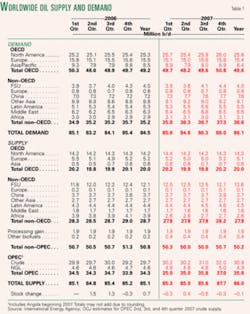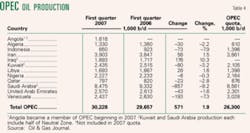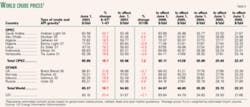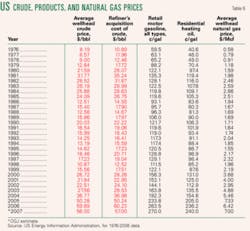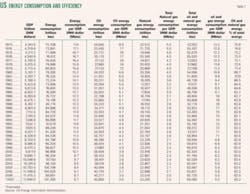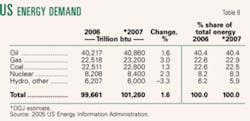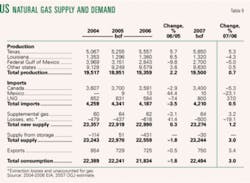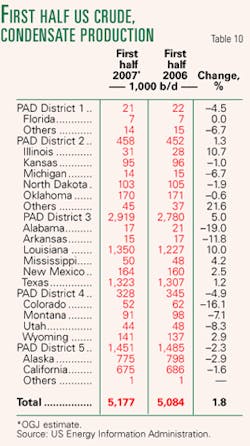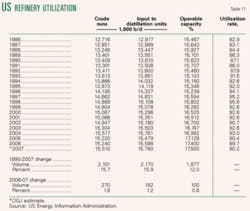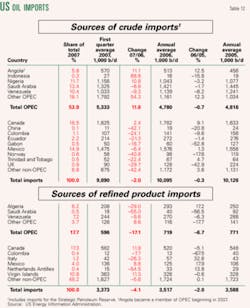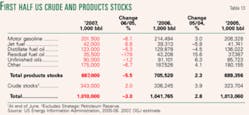Energy demand will increase in the US and worldwide this year as the global economy continues to grow.
In the US, consumption rates for natural gas, oil, coal, and nuclear energy consumption all will climb, but the use of energy from renewable sources will decline slightly.
A gain in US LNG imports will offset a decline in gas imported from Canada, and US gas production will post a small increase this year as demand rebounds after last year’s drop.
The oil market will remain healthy, and US demand for most petroleum products will grow. Inventories of gasoline in the US are tight and look to remain so in the second half of this year, keeping crude and product prices strong. Refinery utilization will increase marginally.
As a result of increased domestic crude production and a small hike in oil demand, US dependence on oil imports will fall slightly from its level of 2006.
Worldwide trends
Worldwide oil demand will climb 2% to an average of 86.1 million b/d this year, according to the International Energy Agency, Paris. The agency forecasts that demand will peak in the fourth quarter, averaging 88 million b/d.
The market will need more crude from the Organization of Petroleum Exporting Countries this year because little oil production growth is expected from countries outside the organization.
IEA figures show that most demand growth will take place in countries outside the Organization for Economic Cooperation and Development. Leading the non-OECD growth will be China, with average demand of 7.59 million b/d, up from 7.16 million last year. Total non-OECD demand will climb 1.3 million b/d this year.
OECD oil demand will climb to 49.6 million b/d from an average of 49.2 million b/d last year. Demand in North America will grow 490,000 b/d, and Canada and Mexico will each register small increases in demand for oil products. Demand in OECD Europe and Pacific countries will decline slightly this year.
OGJ forecasts that worldwide oil supply will average 86 million b/d this year. This assumes that OPEC crude supply rises to average 31 million b/d in the third quarter and 32 million b/d in the fourth quarter. In the first half of 2007, the organization’s members-including Angola, which joined effective Jan. 1-supplied about 30.2 million b/d on average.
OPEC has not officially adjusted its output ceiling since it implemented a planned 500,000 b/d reduction at the start of February 2007. Recent comments from OPEC officials indicate that the organization has no plans to consider a new ceiling before its scheduled September meeting, in spite of high prices. OPEC continues to say that market tightness is the result of refining problems, not crude supply.
Supply from OECD countries will be unchanged this year at 20 million b/d as a dip in European production offsets a small increase in North America.
The former Soviet Union will lead 2007 non-OECD supply growth, according to IEA. The agency expects Russia’s crude and condensate production to average 9.95 million b/d, up 2.6% from last year.
With total non-OPEC supply declining to average 50.2 million b/d this year from 50.8 million b/d and worldwide demand rising, the call for OPEC crude escalates.
Oil prices
In its June 2007 Oil Market Report, IEA said, “While it is clear that much of the recent rise in crude prices has been caused by US gasoline tightness, there is a portion which is related to tighter OPEC supply. Hopes for a moderation in crude prices in the short term therefore lie both with OPEC and the US gasoline market.”
With limited spare oil production capacity and supply disruptions, world crude prices have climbed since the start of 2007. Hostilities in Nigeria-with attacks on pipelines, pumping stations, and offshore vessels-have reduced production levels there.
The price of Nigerian Bonny Light crude on June 1 was $71.04/bbl, up from $60.64/bbl on Jan. 1. The recent price was still slightly below its year-earlier level. Brent Blend crude from the UK and Mexico’s Isthmus crude followed the same price pattern as Bonny Light. Meanwhile, Arabian Light crude on June 1 was up 21% from its Jan. 1 price and a bit higher than its year-earlier price.
Although they have been trending upwards since January, on average 2007 crude prices have declined from a year ago on the New York Mercantile Exchange. For the first half of this year, the front-month contract closed at an average of $61.60/bbl vs. $67.13/bbl in the first half of last year.
OGJ expects the average cost of crude this year for US refiners to decline about 5% from last year’s average of $60.23/bbl. Compared with the first half of 2006, refiners’ crude costs were down about 7% in the first half of this year.
Refiners have benefitted from sour crude oil discounts relative to light sweet crudes. The combination of plentiful supplies of sour grade crude and greater demand for sweet crudes has maintained a discount to West Texas Intermediate as refiners must meet lower sulfur specifications for cleaner fuels.
Product prices
Retail prices of motor gasoline and heating oil stand poised to reach record average levels for 2007, breaking the records they set last year. Refinery problems in the US coupled with strong demand pressured inventories of gasoline throughout the first half of this year, bolstering prices.
Pump prices for all types of gasoline this year will climb, averaging $2.70/gal. Last year’s average pump price across all types of gasoline was $2.635/gal, according to EIA. The peak month last year was July, with an average price of $3.046/gal.
Taxes on regular unleaded self-serve gasoline currently average 43.6¢/gal nationally, up from 42.4¢/gal at the start of last year.
OGJ forecasts that the price of residential heating oil excluding taxes will average $2.40/gal this year. The price averaged a bit higher in the first quarter of this year than during the corresponding 2006 quarter. For all of 2006 heating oil excluding taxes averaged $2.362/gal.
Gas prices
The average US wellhead natural gas price this year will be $7.00/Mcf, up from $6.42/Mcf a year ago.
Gas prices began the year slightly lower than their levels of a year ago. There was plenty of gas in storage, and the number of heating-degree days in January and March was below normal.
In the second quarter, gas futures prices on the NYMEX began to rise amid expectations for an active Atlantic hurricane season and warmer summer temperatures.
During May the closing price of the front-month contract for gas averaged $7.822/MMbtu. During May 2006, the average for the near-month gas contract was $6.373/MMbtu.
US energy
Real gross domestic product, the output of goods and services produced in the US, increased at an annual rate of 0.6% in the first quarter of 2007, according to preliminary estimates by the Bureau of Economic Analysis. That was less than half the growth rate BEA had predicted earlier and followed a fourth-quarter 2006 growth rate of 2.5%/year.
Although GDP growth has slowed from last year, many economic indicators remain positive for growth.
Real personal consumption expenditures increased 4.4% in the first quarter of 2007, compared with an increase of 4.2% in the fourth quarter of last year. Excluding energy and food prices, US inflation has been little changed this year, and unemployment remains low.
In May, the consumer price index rose just 0.7%, and unemployment was 4.5%, according to the US Department of Labor’s Bureau of Labor Statistics. First-quarter 2007 productivity in the nonfarm business sector picked up 1% from the fourth quarter of 2006.
OGJ forecasts that GDP this year will grow 2%. Last year’s growth rate was 3.3%. Some of the pull on economic growth so far this year has been the weak housing market.
With this year’s increase in economic activity there will be a small increase in energy consumption. Total energy demand in the US will grow 1.6%. Since this pace is below the rate of growth in GDP, energy efficiency will improve to 8,699 btu/$ of GDP from 8,730 btu/$ during 2006.
Energy sources
Total energy demand in the US will be 101.26 quadrillion btu (quads) this year. Use of most sources of energy will increase from last year, but a decline in the use of hydroelectric power will result in a decrease in total demand for energy from renewable sources. Natural gas will account for a larger share of the energy mix, while oil, coal, and nuclear energy are nearly unchanged from their 2006 shares.
Oil will remain the largest component of the energy mix at 40.4%. US demand for petroleum products will increase 1.6% this year and total 40.86 quads. Consumption of all the major products will exceed last year’s.
The energy source that will grow the most this year is gas, demand for which will climb 3% and represent 22.9% of the US energy market. Larger gas deliveries to residential customers and electric power providers will propel demand.
Coal consumption will increase to 22.8 quads from 22.5 quads last year. Electric utilities and independent power producers are driving coal demand growth, as demand by residential users and coke plants is waning.
Nuclear energy net generation will climb 2.3% to a record high 8.4 quads this year. In the first quarter of 2007, the 104 operating nuclear units in the US ran at an average 94% of capacity, according to EIA. Nuclear energy will account for 8.3% of total US energy demand this year.
The total of all forms of renewable energy used will be 6 quads, down 3.3% from last year. Hydro demand is down due to below-normal precipitation in the northwestern US. Renewable energy sources, which include solar, hydro, wind, wood, and others, are mostly used by industrial and electric power customers.
In the first 3 months of 2007, conventional hydroelectric power consumption was down 11% from a year earlier. During the same period electricity generation from wind grew 18% but still totaled just 79 trillion btu for the quarter.
US gas market
Electric power and residential customers will push total gas demand to 22.49 tcf this year.
Gas is in greater demand as a result of more heating-degree days in the first 4 months of 2007 than during the same 2006 period and a summer that’s expected to be warmer than normal. Also, experts at the National Oceanic and Atmospheric Administration Climate Prediction Center project a 75% chance that Atlantic hurricane activity will be above normal this year.
NOAA scientists predict 13-17 named storms, with 7-10 becoming hurricanes, of which 3-5 could become major hurricanes of category 3 strength or higher. With this level of activity, production from the Gulf of Mexico and along the Gulf Coast is at risk to sustain substantial disruptions.
Still, OGJ predicts that US gas production will be little changed from last year, up 0.7% to 19.5 tcf. Production gains in Texas and some other states will outweigh declines of 5% in the federal Gulf of Mexico and 4.3% in Louisiana. US gas imports will increase to 4.21 tcf from last year’s 4.19 tcf. LNG imports will surge, but pipeline imports of gas from Canada and Mexico will fall. The US will export 750 bcf of gas this year, up from 725 bcf in 2006.
The US will import 800 bcf of LNG this year, up 37%. High US gas prices relative to prices in Europe accelerated import growth in the first half.
The additional supply from LNG imports will help alleviate market tightness and high gas prices during the peak cooling months of 2007 and will provide insurance against lost production should hurricanes interrupt gas production in the gulf.
In March LNG imports rose to 86.83 bcf from 42.56 bcf the previous month and 33.16 bcf in March 2006, according to Waterborne Energy Inc.
The amount of working gas in storage will finish 2007 nearly the same as at the start, up 30 bcf. At the midyear point, gas inventories are near the top of the 5-year range, where they remained throughout the first 6 months.
US oil demand
Demand for oil products in the US this year will average 20.9 million b/d, up from 20.6 million b/d last year. Demand for transportation fuels and power generation are behind this growth.
In spite of strong pump prices, motor gasoline demand will increase to 9.35 million b/d from 9.23 million b/d last year. Last year demand grew 0.8% as the average pump price surged almost 13%. This year’s higher pump prices and faster rising demand seem to indicate that drivers have adjusted to paying more for fuel.
The year’s growth in jet fuel demand will be minimal, up 1% to 1.64 million b/d. Although passenger travel by air is up from a year ago, airlines are being more efficient as a result of high jet fuel prices.
Demand for distillate will be up 2.5% to average 4.275 million b/d this year as a result of greater use of diesel fuel. In the first 5 months of this year, demand climbed 2.6% from a year earlier, according to the most recent EIA data available.
Diesel fuel has been in greater demand since ethanol requirements for motor gasoline went into effect, because the oxygenate cannot be transported via pipeline to markets from plants predominantly located in the Midwest.
Residual fuel oil demand will increase to 780,000 b/d from 681,000 b/d last year. Resid demand fell 26% last year, primarily due to reduced demand at power plants that had the capability to switch to natural gas for fuel. OGJ forecasts that resid and gas prices will be nearer parity on a btu basis this year.
Use of LPG will average 2.1 million b/d this year, up 2.7%. In the first quarter of this year, production of LPG at gas processing plants and at refineries was up, and exports were down from the first quarter of 2006.
Demand for all other petroleum products this year will decline 2%. This group includes naphtha jet fuel, pentanes plus other hydrocarbons and oxygenates, unfinished oils, gasoline blending components, and all finished petroleum products except finished motor gasoline, distillate, resid, jet fuel, LPG, and crude oil that is used as fuel.
US oil supply
Total US liquids production this year will average 6.96 million b/d, up 1.3%.
Helping to boost supplies are a few major projects expected to begin production by yearend in the Gulf of Mexico. These include BHP’s Thunder Hawk, BP’s Atlantis, and Anadarko’s Independence Hub.
Production of crude oil and condensate will average 5.2 million b/d, up from 5.14 million b/d. NGL and liquefied refinery gas production will climb 1.4% to 1.76 million b/d.
Through the first half of 2007, OGJ estimates that oil production was 5.177 million b/d, up 1.8% from the first half of last year. Onshore and offshore production was up slightly in Texas and up 10% in Louisiana.
Production was down in California, Colorado, and Montana for the first 6 months. And Alaskan output continued its slide, averaging 775,000 b/d vs. 798,000 b/d in the first 6 months of last year.
Imports
US oil imports will increase 1.1% this year. Imports of both crude and products will grow, averaging 13.76 million b/d.
OGJ forecasts that 2007 crude imports will average 10.2 million b/d, and imports of oil products will average 3.56 million b/d. The US resumed importing crude for the Strategic Petroleum Reserve in March, according to EIA. This is the first month of imports for the SPR since May 2006.
For the third straight year, Canada was the largest source of US imported crude oil in 2006, when the US received an average 1.782 million b/d from the country.
The second largest source for US crude imports last year was Mexico, followed by Saudi Arabia, Venezuela, and Nigeria.
US crude imports from OPEC member countries averaged 4.78 million b/d last year, up slightly from a year earlier. Oil product imports from OPEC countries averaged 719,000 b/d, down from 2005.
Canada also was the leading source of US product imports last year. The US imported an average of 521,000 b/d of products from Canada, a bit less than during the prior year. The next largest sources of products imported by the US last year were the US Virgin Islands, Algeria, Venezuela, and Russia.
Oil inventories
Crude and product inventories will finish this year nearly unchanged from the end of 2006. Crude stocks will be slightly lower at 310 million bbl, while product stocks will total 700 million bbl.
Crude stocks finished the first half of 2007 about 3% higher than at mid-2006. But inventories of most oil products were lower than a year earlier because of strong demand and refinery problems.
Half-way through this year, stocks of motor gasoline were down 5% from a year earlier. Inventories of resid were down 16%, and distillate stocks were 3% lower. At the same time, jet fuel stocks were about 2% higher than at the end of June 2006.
At the midpoint of this year, the amount of crude in the SPR was 690 million bbl, barely up from a year earlier. Since imports of crude for the reserve have resumed, OGJ forecasts that SPR stocks will be 700 million bbl at the end of this year. At the end of 2006, SPR stocks totaled 688.6 million bbl.
Refining
OGJ forecasts that this year’s average US refinery utilization will be 90.2%, up from 89.7% last year. This assumes total inputs to refineries of 15.78 million b/d with operable capacity of 17.5 million b/d.
For the first 5 months of this year, US refinery utilization was 87.8%, roughly the same as a year earlier when some Gulf Coast refineries were struggling to resume normal operations following damage from the previous year’s hurricanes.
US refinery activity in the first half of this year was hampered by numerous outages and unscheduled shutdowns for maintenance, which led to lower product inventories. At the same time demand for products was strong, up from a year earlier. Limited supply and strong demand pushed up product prices.
Refiners have had healthy cash margins for a couple of years.
The Gulf Coast cash refining margin last year averaged $12.52/bbl, according to Muse, Stancil & Co. This compares with a 2005 average of $12.90/bbl. For the first 5 months of this year, that margin averaged $15.10/bbl, up 9.5% from the corresponding 2006 period.
But West Coast margins have been much higher than that, averaging $23.98/bbl for 2006 and $27.71/bbl for the first 5 months of this year. The monthly average for the West Coast margin peaked in May 2006 at $39.61/bbl.
There are still no firm plans to build a new refinery in the US, so operations will stay close to capacity rates unless demand slumps. Companies have weakening incentive to build capacity in light of calls for limits on the use of hydrocarbons and the rigorous permitting required for new facilities.
